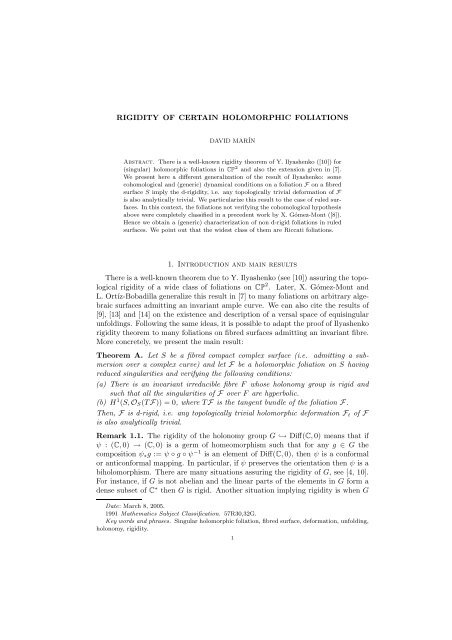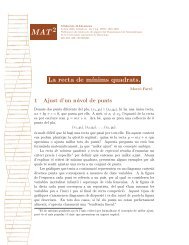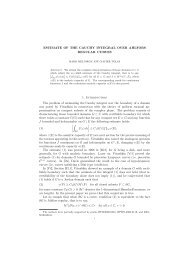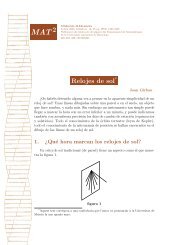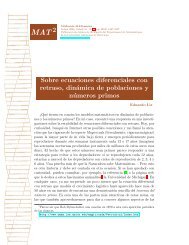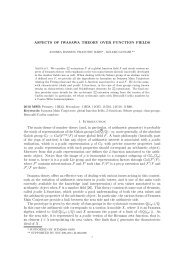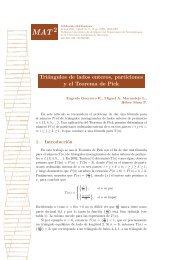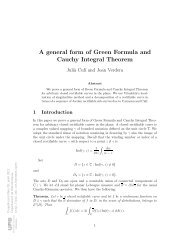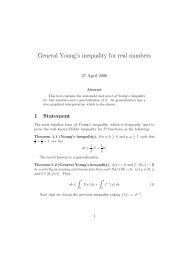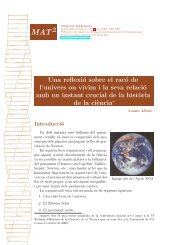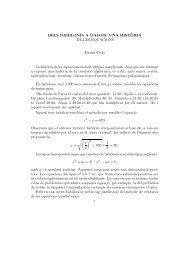RIGIDITY OF CERTAIN HOLOMORPHIC FOLIATIONS 1 ...
RIGIDITY OF CERTAIN HOLOMORPHIC FOLIATIONS 1 ...
RIGIDITY OF CERTAIN HOLOMORPHIC FOLIATIONS 1 ...
You also want an ePaper? Increase the reach of your titles
YUMPU automatically turns print PDFs into web optimized ePapers that Google loves.
4 DAVID MARÍNp i . We can write ψ i (z, t) = (ψi t(z), t) if z ∈ Σ0 i ⊂ C and t ∈ ∆. The hyperbolicityof that singularity on C ∗ implies that(1)∂∣ ∣∣∣∣ ∣ ψi t ∂z(z) < 1z=0holds for t = 0, where the coordinates of the point p i are (z, t) = (0, 0). Hence, if∆ is small enough then (1) also holds for every t ∈ ∆. Let Z i be the fixed set ofψ i . Thanks to (1), we can apply the Implicit Function Theorem to conclude thatZ i is a regular curve in V i which is locally the graph of a holomorphic functionz i : ∆ → Σ 0 i ⊂ C with z i (0) = 0. It is easy to see that C i = ϕ i (Z i ) ⊂ V i andconsequently, the leaf C i is holomorphic.(II) Since z i : ∆ → Σ 0 i is holomorphic, we can change the coordinates in orderto have z i ≡ 0 and therefore C i = ϕ i ({0} × ∆). Let us consider the local homeomorphism¯φ t i : (C, 0) → (C, 0) which makes commutative the following diagram:U i ∩ S t⏐↓ϕ t iφ t−−−−→(C, 0) −−−−→¯φ t iUi⏐↓ϕ 0 i(C, 0)where S t = π −1 (t) and φ t = Φ |St . By construction, ¯φ t i is a topological conjugationof the holonomies of C t = φt−1 (C) and C with respect to the foliations by curvesF t = F|S ∆ tand F. Hypothesis (b) implies that ¯φ t i (z) is holomorphic with respect tothe coordinate z. We shall see that ¯φ t i is also holomorphic with respect to the coordinatet ∈ ∆. To prove this, we consider an analytic family of contractive holonomydiffeomorphisms ψi t conjugated to ψ0 i by ¯φ t i . Thanks to the Schroeder linearizationtheorem for analytic families of diffeomorphism of (C, 0), cf. for instance [7], thereis an analytic family of linearizing coordinates ζ t such that ¯φ t i (ζ t) = σ(t)ζ 0 for somecontinuous function σ : ∆ → C ∗ . Since the holonomy group G is rigid and containsa contractive element, we deduce that G is non abelian. Therefore, there exists anelement g ∈ G such that g(ζ 0 ) = ∑ a k ζ0 k with a k ≠ 0 for some k > 1. Since theholonomy element(¯φ t i )−1 ◦ g ◦ ¯φ ∞ t i = ∑ a kσ(t) k−1 ζk tdepends analytically on t, we conclude that σ is holomorphic and consequently¯φ t i also is holomorphic with respect to t. It is easy to see that G i is defined in aneighborhood of C i by the level sets of the map (z, t) ↦→ ¯φ t i (z).(III) Since the hypothesis (ii) is purely topological, it is also verified by (S t , F t , C t ).Therefore, for every j, the set Vj∗ of points ϕ j (p) ∈ V j such that the leaf of F ∆through p is adherent to C = Φ −1 (C × ∆) = ⋃ C t in regular points is an open setwhose complementary is a finite union of plaques of G j . Point (II) implies that C isa holomorphic leaf of the topological foliation G top having a neighborhood where itis holomorphic. Consider (z, t) ∈ Vj ∗ and p ∈ U j such that ϕ j (p) = (z, t). Since theleaf L t de F ∆ through p accumulates C t in regular points, there exists q ∈ L t ∩ U iclose enough to C t such that G i is holomorphic in a neighborhood of ϕ i (q) ∈ V i .Let γ be a path inside L t joining the points p and q, and consider the holonomytransformation ψ γ : V j → V i of the foliation F ∆ associated to γ. It is easy to seek=1t∈∆
6 DAVID MARÍNTheorem 3.4 (Ghys). If F is a codimension one (possibly singular) holomorphicfoliation on a compact, connected complex manifold, then F has only a finite numberof closed leaves except when F admits a meromorphic first integral, in which caseall leaves are closed.Now, we proceed to continue with the following step of the proof of Theorem A.Proposition 3.5. Under the hypothesis of Theorem A, if we put C = F then thehypothesis of Theorem 2.1 hold.Proof. First of all, we point out that if a leaf L of F meets all the fibres of π ina finite number of points then L is compact. Indeed, the restriction of π : S → Bto L is finite and hence it is a proper map. Secondly, we note that the existenceof a meromorphic first integral of F in S is not allowed because the hyperbolicityof the singularities of F on F. From Theorem 3.4 we deduce that there is a finitenumber of compact leaves of F.Let L be a non compact leaf of F, i.e. L \ L ⊄ Sing(F). Using the notationsof Remark 3.2, we fix a point b 0 in B ∗ and a path γ : [0, 1) → B ∗ such thatlim γ(t) exists and is equal to b 1 = π(F). For each 0 < t < 1 and for eacht→1point p of L ∩ π −1 (b 0 ), we consider the lift ˜γ t of γ restricted to [0, t] to the leafL such that ˜γ t (0) = p. The compactness of S implies that the set A(γ) ⊂ F ofaccumulation points of ˜γ t , when t tends to 1 and p ranges L∩π −1 (b 0 ), is nonempty.The hyperbolicity of the singularities of F along F implies that A(γ) containsnecessarily some regular point of F.□4. Some facts about versal unfoldingsA holomorphic unfolding G of a singular foliation F (over a parameter space P ofarbitrary dimension) on a complex surface S is an unfolding admitting a reductionof the singularities with parameters, see for instance [14] for a proper definition. Anunfolding G ver of F over P ver is called versal if it contains any other unfolding Gof F over P. More precisely, if the there exist a map λ P : P → P ver such that wecan complete the pull-back diagram, i.e., S ∼ = λ ∗ P Sver :λS −−−−→ S ver⏐ ⏐↓ ↓λP −−−−→PPverand G ∼ = λ ∗ G ver . In [14], a versal equisingular unfolding is constructed for every foliationF, being P ver a (possibly singular) analytic space. Under some cohomologicalassumptions (H 1 (S, O S (T F)) = H 2 (S, O S (T F)) = 0) there it is showed that P veris smooth and naturally identified with the product of local the parameter spacesPiloc corresponding to the local equisingular versal unfoldings of the germs of F ateach singular point p i of F (see also [13]).It only remains to note that under the hypothesis of Theorem A, the parameterspace of the versal equisingular unfolding of F is trivial. This is a consequence ofthe works of X. Gómez-Mont, cf. [9] and J.-F. Mattei and M. Nicolau, cf. [13, 14].Indeed, if all the singularities of F are reduced then Piloc = 0. This is also the caseif all them have Milnor number equal to one and non vanishing trace, see [9]. If,in addition, H 1 (S, O S (T F)) = 0 then we have P ver = 0, i.e. every equisingular
<strong>RIGIDITY</strong> <strong>OF</strong> <strong>CERTAIN</strong> <strong>HOLOMORPHIC</strong> <strong>FOLIATIONS</strong> 7unfolding is analytically trivial. To finish the proof of Theorem A, we need onlypoint out that every unfolding of F is equisingular provided that all the singularitiesof F are reduced.References[1] M. Belliart, I. Liousse, and F. Loray. Sur l’existence de points fixes attractifs pour les sousgroupesde Aut(C, 0). C.R. Acad. Sci. Paris, Série I, 324:443–446, 1997.[2] Marco Brunella. Birational geometry of foliations. Monografías de Matemática. [MathematicalMonographs]. Instituto de Matemática Pura e Aplicada (IMPA), Rio de Janeiro.[3] Marco Brunella. Feuilletages holomorphes sur les surfaces complexes compactes. Ann. Sci.École Norm. Sup. (4), 30(5):569–594, 1997.[4] Dominique Cerveau and Paulo Sad. Problèmes de modules pour les formes différentiellessingulières dans le plan complexe. Comment. Math. Helv., 61(2):222–253, 1986.[5] Raymond Gérard and Antoinette Sec. Feuilletages de Painlevé. Bull. Soc. Math. France,100:47–72, 1972.[6] Étienne Ghys. À propos d’un théorème de J.-P. Jouanolou concernant les feuilles fermées desfeuilletages holomorphes. Rend. Circ. Mat. Palermo (2), 49(1):175–180, 2000.[7] X. Gómez-Mont and L. Ortíz-Bobadilla. Sistemas dinámicos holomorfos en superficies. SociedadMatemática Mexicana, México City, 1989.[8] Xavier Gómez-Mont. Holomorphic foliations in ruled surfaces. Trans. Amer. Math. Soc.,312(1):179–201, 1989.[9] Xavier Gómez-Mont. Unfoldings of holomorphic foliations. Publ. Mat., 33(3):501–515, 1989.[10] Yu. S. Ilyashenko. Topology of phase portraits of analytic differential equations on a complexprojective plane. Trudy Sem. Petrovsk., (4):83–136, 1978.[11] J. P. Jouanolou. Hypersurfaces solutions d’une équation de Pfaff analytique. Math. Ann.,232(3):239–245, 1978.[12] David Marín and Marcel Nicolau. Riccati foliations on ruled surfaces. (En preparation), 2005.[13] Jean-François Mattei. Modules de feuilletages holomorphes singuliers. I. Équisingularité. Invent.Math., 103(2):297–325, 1991.[14] Jean-François Mattei and Marcel Nicolau. Equisingular unfoldings of foliations by curves.Astérisque, (222):6, 285–302, 1994. Complex analytic methods in dynamical systems (Rio deJaneiro, 1992).[15] Isao Nakai. Separatrices for nonsolvable dynamics on (C, 0). Ann. Inst. Fourier (Grenoble),44(2):569–599, 1994.[16] M. P. Painlevé. Leçons sur la théorie analytique des équations différentielles. Librairie scientifiqueA. Hermann, 1897. Leçons professées a Stockholm, 1895.Departament de Matemàtiques, Universitat Autònoma de Barcelona, E-08193 Bellaterra(Barcelona), SpainE-mail address: davidmp@mat.uab.es


